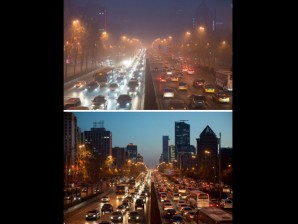
This combination of photos shows Beijing’s second ring road during heavily polluted weather (top) on January 30, 2013, and during clear weather (bottom) on February 1, 2013. Residents across huge swathes of northern China have in recent weeks battled through choking pollution at extreme levels, as Beijing was plunged into toxic twilight for the fourth time this winter. AFP
TOKYO—The suffocating smog that blanketed swathes of China is now hitting parts of Japan, sparking warnings Monday of health fears for the young and the sick.
The environment ministry’s website has been overloaded as worried users log on to try to find out what is coming their way.
“Access to our air-pollution monitoring system has been almost impossible since last week, and the telephone here has been constantly ringing because worried people keep asking us about the impact on health,” said an environment ministry official.
Pictures of Beijing and other Chinese cities shrouded in thick, choking smog played out across television screens in Japan last week.
News programs have broadcast maps showing a swirl of pollution gathering strength across China and then spreading out over the ocean towards Japan.
Pinks, reds and oranges that denote the worst pollution form a finger of smog that inches upwards to the southern main island of Kyushu.
Relations between Tokyo and Beijing are already strained, over the sovereignty of a chain of islands in the East China Sea.
Officials were coy about lumping the blame all on their huge neighbor, but Yasushi Nakajima of the environment ministry said “we can’t deny there is an impact from pollution in China”.
Air pollution over the west of Japan has exceeded government limits over the last few days, with tiny particulate matter a problem, said Atsushi Shimizu of the National Institute for Environmental Studies (NIES).
Prevailing winds from the west bring airborne particles from the Asian mainland, he said.
Of specific concern is the concentration of a particle 2.5 micrometers or less in diameter, which has been as high as 50 micrograms per cubic metre of air over recent days in northern Kyushu.
The government limit is 35 micrograms.
Yellow sand from the deserts of Mongolia and China is a known source for these particles, as are exhausts from cars and smoke from factories.
“At this time of year they are definitely not yellow sands so they’re toxic particles,” Shimizu said, warning that “people with respiratory diseases should be careful.”
Toshihiko Takemura, associate professor of Kyushu University who runs another air pollution monitoring site, said “the impact of air pollution originating from China on Japan was scientifically discovered more than a decade ago”.
“Especially in Kyushu, the level of air pollution has been detectable in everyday lives since a few years ago,” he said.
“People in eastern and northern Japan are now belatedly noticing the cross-border air pollution,” he told AFP.
Takemura noted that pollution in Japan over the last few days has not been quite as bad as it was in February 2011, when “very hazy days continued for several days in western Japan.”
He agreed with Shimizu that people with respiratory disease, as well as small children, should take extra care to avoid the problems.
Takemura’s website forecast an “extremely large” amount of air pollutants would arrive in part of Kyushu Monday and Tuesday.
Shimizu said information-sharing with China on air pollution has been difficult but “there are many things Japan can do, for instance encouraging China to use pollutant-filtering equipment in factories.”